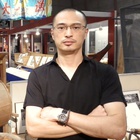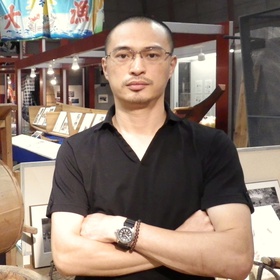Art’s Function and Role in Society
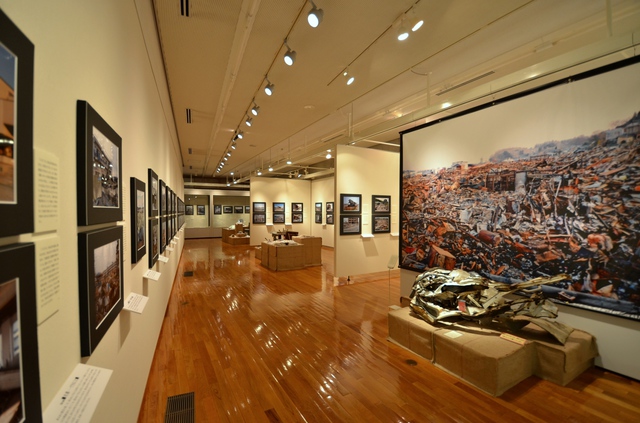
A Unique Presence--The Rias Ark Museum of Art
The Rias Ark Museum of Art is located on a hill in Kesennuma, Miyagi Prefecture. It is a public art museum operated by Kesennuma City and Minamisanriku Town which opened in 1994, celebrating its 20th anniversary this year. I have been serving as the curator of the museum since shortly before it opened.
The museum opened almost at the same time as the collapse of the bubble economy, and before ever experiencing a stable operation, the museum was hit by the Great East Japan Earthquake or what could be called the ultimate predicament. It was not an easy task to take charge of the management of a museum when cultural administration tended to be regarded as the most wasteful in the midst of a sluggish local economy, but as a result of our active efforts, the museum was able to resume operations after the earthquake.
The turning point came in the year 2000. At that time, operation of the museum was becoming difficult due to financial issues, and as a countermeasure we were forced to undertake a radical reform of its intangible aspects.

Exterior of the Rias Ark Museum of Art
The museum had a permanent exhibition of local historic and folklore materials since its inception, but they were not appreciated by the local residents and were labeled, “The Cupboard Art Museum,” which was a cause of headache for us as well. In order to make effective use of the permanent exhibition which was not functioning up to that point, I designed and opened a new permanent exhibition called “The Ark Diary” with a concept of “deciphering the local history, folklore, and lifestyle culture through food.” If a local museum is to show its local culture, it should be centered around what the locals are proud of. For the Kesennuma region, that was “food.”
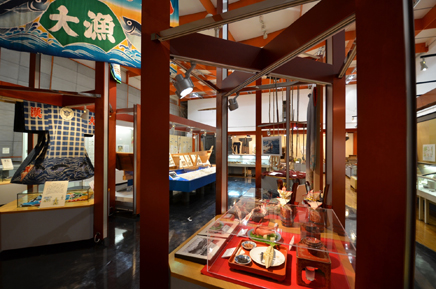
Permanent Exhibition “The Ark Diary”
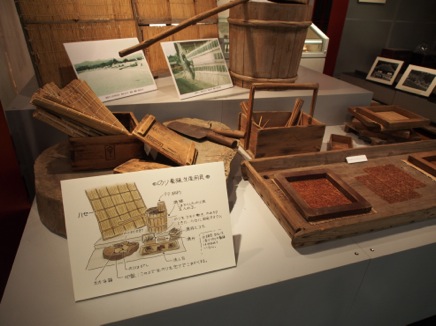
Permanent Exhibition “The Ark Diary”: With a characteristic commentary panel with hand-drawn illustrations. Permanent Exhibition “The Ark Diary”
With a characteristic commentary panel with hand-drawn illustrations.
Illustrations by: Hiroyasu Yamauchi
The permanent exhibition, “The Ark Diary” became highly acclaimed locally, and owing to this permanent exhibit, the museum became deeply involved in the major movement of community development. The cooperation in particular with the slow food movement, with which the town as a whole had started to work on, dramatically increased the existential value of the museum in the region.
The objective of the slow food movement in Kesennuma is to recognize the local cultural resources from the perspective of food and connect them with the local industries to promote community development. My responsibility and the role of the museum in this movement is the management of identifying cultural definitions. Kesennuma is currently certified as a Slow City.
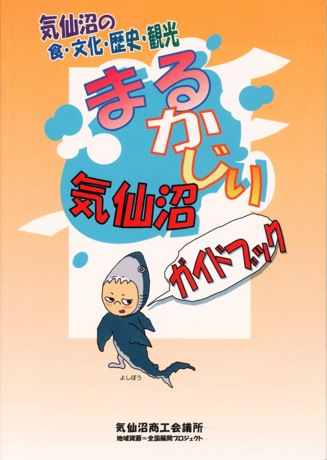
Collaboration Project with the Slow Food Movement―”Marukajiri Kesennuma Guidebook”
Planning & Editing: Hiroyasu Yamauchi, Slow Food Kesennuma
Editorial supervision: The Rias Ark Museum of Art
Published by: Collaboration Project of Kesennuma Chamber of Commerce and Industry and the Slow Food Movement
Involvement with Tsunami
Before the disaster, I had begun an endeavor of considering tsunamis as an element of local culture. In 2006, I organized an exhibition that showed the realities of the Meiji Sanriku Tsunami. In 2008 I published a novel on the same theme to raise an alarm about the imminent threat of tsunami disaster, and I have continued to talk about the relationship between local culture and tsunamis. On 11 March 2011, the city was devastated, and I too became a victim.
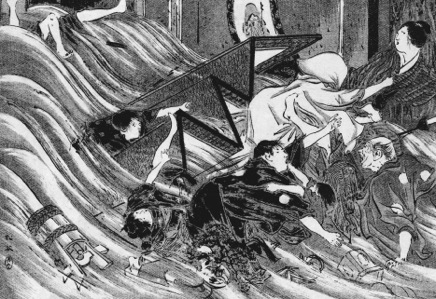
“A painting of a wedding ceremony hit by a tidal bore in Utatsu Village (Irimae),” from the illustrated magazine, Fuzokugaho records of the disaster of the large tidal bore”
“A painting of a wedding ceremony hit by a tidal bore in Utatsu Village (Irimae)”
Immediately after the earthquake, I went to the stricken areas with several members of our curatorial staff and recorded all the sites in the locality hit by the disaster. The purpose was not to record the damages caused by the disaster, but to record the last images of a community that had been established up to that point. A tsunami might take everything away but that does not mean our culture will also be taken away. But if you don't leave behind any clues for future regeneration, the local people will have no means to remember them. We literally risked our lives to record the disaster for local regeneration.
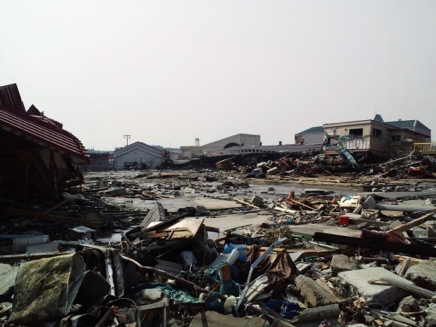
Photo of the disaster-stricken area
March 13, 2011, state of Benten-cho, Kesennuma. This is the district where Yamauchi's house was. Our purpose for entering the stricken areas was to check on the conditions of the houses, but above all, it was to check on the safety of the pets left behind. The aftershocks did not subside, and sea levels continued to change, and smoke was rising from disaster-affected objects. My home, which was equivalent to a four-story steel framed building, had disappeared without a trace, leaving two steps of concrete from the foundation. Photo of the disaster-stricken area
March 13, 2011, state of Benten-cho, Kesennuma. This is the district where Yamauchi's house was. Our purpose for entering the stricken areas was to check on the conditions of the houses, but above all, it was to check on the safety of the pets left behind. The aftershocks did not subside, and sea levels continued to change, and smoke was rising from disaster-affected objects. My home, which was equivalent to a four-story steel framed building, had disappeared without a trace, leaving two steps of concrete from the foundation.
Photograph by: Hiroyasu Yamauchi
The results of our two-year survey efforts to record the disaster became a permanent exhibition called, “The Records of the Great East Japan Earthquake and the History of Tsunami Disasters” and is now open to the public at the museum.
The content of this permanent exhibition is often criticized as being harsh to the victims. It is because the exhibition postulates that, “disasters are caused by human beings.” And unless people change, tsunami disasters will never be prevented. That we must reconsider the local history and culture, and with a deep sense of regret, build our future responsibly.” It is precisely because I am a victim myself that I am able to talk from that perspective. And precisely because I am a victim of the disaster, I believe that I must reflect on myself as well.
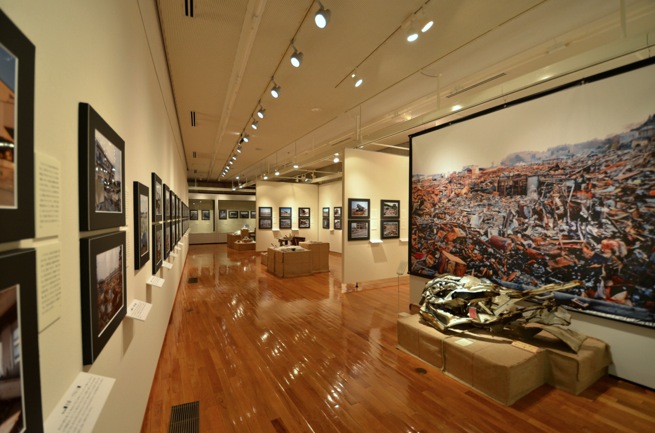
The Rias Ark Museum of Art “The Records of the Great East Japan Earthquake and the History of Tsunami Disasters” Photo of the permanent exhibition venue
Earthquake Disaster and Art
Immediately after the earthquake, familiar young artists often said, “We are powerless.” Artists who were struck by a sense of helplessness started various actions to get out of such state of mind. There were some who said, “The only thing I can do is to keep on creating as before,” and tried to help by producing and selling their work, donating parts of the sales. Those were wonderful acts of benevolence. But is it really so, that there is nothing we can do but to only continue to create as before? I do not believe that.
It seems that the artists' feelings of helplessness stemmed from being speechless at seeing the cruelty of the fact that “everything that is ever created gets destroyed.” Perhaps it was a sense of despair towards creating things, or a feeling of futility, or the sheer powerlessness of human beings in the face of nature’s might. Maybe they had overlapped those helplessness with their own powerlessness in society.
Although I have been expressing through art as an artist myself, I felt that I could not continue as before after witnessing such gut-wrenching conditions. At least for the Japanese people who will be working as artists from now on, I wanted them to see and feel the reality and sublimate it in their own ways. If an artist is said to be a person with a sharp sensitivity and the ability to express the feelings captured in diachronic and synchronic ways, I think an artist will naturally know what he is supposed to express when he takes an objective view of the disaster through that outstanding ability.
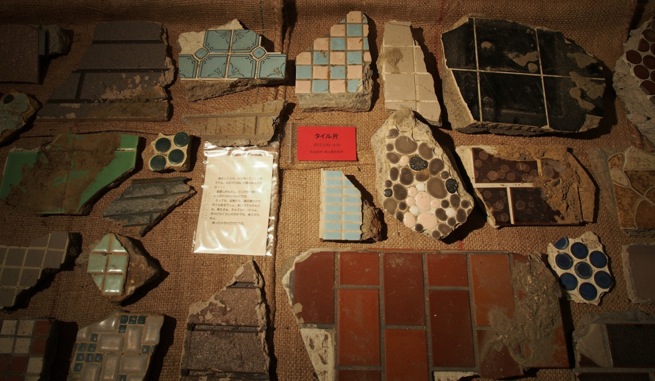
A collection of disaster-affected objects: “Tile pieces: 30.3.2012-20.4.2012 from various locations in Minamisanriku, Kesennuma City.”
The affected objects are displayed as a form of installation art. Each have a postcard attached with their accompanying stories.
[Tsunami is something that takes everything away, so there’s nothing left... just the foundation, so you don’t know whose house was where. But even so, there’s the entrance and the bathroom tiles. So you know. That’s how I knew too. Even a piece of fragment as small as the size of your palm is still your house. Although that's the only thing that was left. ]
The idea that “Art will keep alive the memories of this earthquake disaster.”
The Rias Ark Museum of Art is designated as an art museum. It is true that some people voice their doubts as to why an art museum has a permanent exhibit of the earthquake disaster materials and the cultural history of tsunamis. But, if the meaning of art is a “human expression created through the interaction of worldly events and human beings,” then I feel that the permanent exhibition of the earthquake disaster materials currently held by this museum does not deviate from that line of thinking.
The materials on display by the museum are intended for gaining a closer look at the historical background which augmented the tsunami disaster. And they must become timeless historical materials for thinking about “how we are supposed to live in this present point in time.”
In order to prevent the historical materials from becoming a mere time capsule, it is necessary to convert them into equivalent expressions and media that suit the period, and turn them into living information that can be easily understood and reflected by the people in their everyday lives. I believe that artists who are experts in the act of expression should be in charge of supporting this evolution.
The permanent exhibition of the earthquake disaster materials by the museum creates an opportunity for artists to see the materials. And when you realize that a tsunami disaster, which at first glance can only be thought of as a natural disaster, actually has a lot of man-made aspects to it arising from historical and cultural backgrounds, artists will no doubt turn it into a subject of their expression.
I feel that if the various issues that were left behind by the earthquake disaster were expressed in artworks rather than as simple records, it would be possible to pass on the memories of the disaster to future generations. Art must have that power, that ability to stimulate the five senses of human beings and change a third person into a person involved by conveying a feeling of pseudo-reality.
I believe that the role of art is not to “comfort the victims and the disaster-stricken areas” but to “express this reality.” The power to reproduce things that were lost, the power to reproduce the time that had passed, the power to convey a sensation that should not be forgotten, and the power to manifest the sense of aesthetics indispensable in people's normal lives. These I think are the powers of art.
As an artistic experiment, I made the records of the Great East Japan Earthquake into a permanent exhibition at the museum. To give a figurative example, the display can be likened to the fillet after a fish has been caught and prepared. And henceforth, I hope that many artists will use it as a material to cook (sublimate) into an expression that will be suitable for the generation.
(February 26, 2014)
Activity Data
The Rias Ark Museum of Art (Kesennuma City, Miyagi Prefecture) opened in October 1994. Main operation is managed by Kesennuma and Motoyoshi Wide Area Administrative Association. An atypical public museum that exhibits mainly contemporary art while having a permanent exhibition of history and folklore to disseminate local culture.
The principle policy of the museum is research focused on art from Tohoku and Hokkaido. At the same time, they are conducting research on the local culture of the area, especially the history and folklore centered around the fishing village culture and food culture. Since 2006, they have been studying and disseminating the history of tsunami disaster and cultural history.
Related Links
Net TAM memo
Three years have passed since the Great East Japan Earthquake. A passage of time imbued with emotions different for each individual. Net TAM started this series from September 2011, and since then people from various walks of life have written their feelings in facing the disaster and the reconstruction. Every time it was published, we could hear those voices that told us, “not there yet,” but we could also hear the definite sounds of the “step by step” forward, and it seemed that the outline of the role of art was been drawn over time.
The Rias Ark Museum of Art is a museum rooted in local culture, where collections, exhibitions, and research of local history and folklore materials are conducted. And Mr. Yamauchi has continued to work to shed light on the buried history, and to express the footprints of our ancestors in the appropriate form to send a message to us who are living in the present age. There was a firm basis for his viewpoints he had cultivated as a curator and the words uttered from his standpoint as an artist affected by the disaster. It brought us back to the essence of art and made us realize the power of art, and clearly pointed out the role of art in this disaster as well as in our future. The issues which were discovered through the numerous records of the disaster by Mr. Yamauchi who had regarded tsunami as an element of local culture from before the earthquake, are something that should be addressed perhaps not only by the people affected by the disaster, but by all mankind.
And to hear “more and more,” of those steps forward, Net TAM will continue to work into the future.
